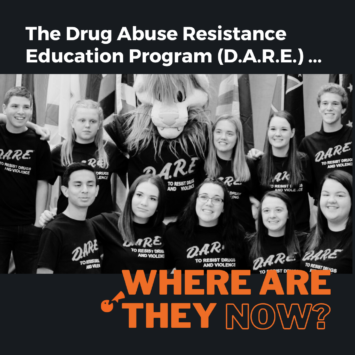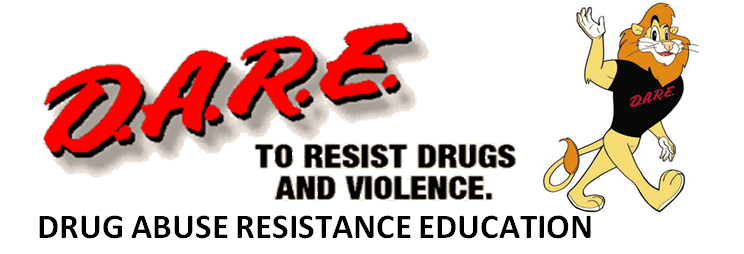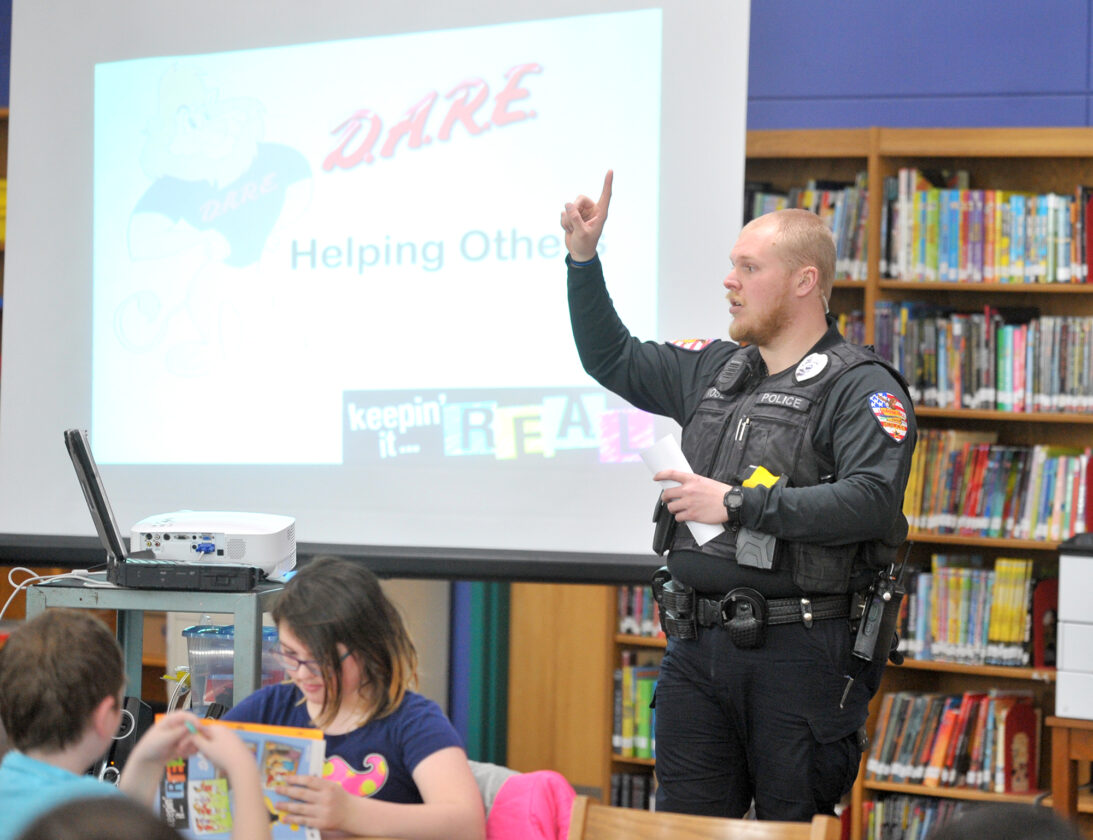
D.A.R.E. Where are they now?
This email series is a throwback to behavior change campaigns that ran on TV and in magazines when I was a kid. Enjoy the nostalgia of old ads and the thrill of discovering where they are now!

D.A.R.E.
Where are they now?
D.A.R.E. stands for the Drug Abuse Resistance Education Program. This program was launched in the early 1980s in response to the U.S.A.’s “war on drugs” as a demand-side strategy to prevent present-day and future teenagers from using drugs.

You may remember the “Just say no” slogan from this era, created in 1982 by first lady Nancy Reagan. Her initiative was the national anti-drug effort that sparked local programs targeting children and teenagers.
D.A.R.E. was one of the programs to emerge from this national effort, described as a “comprehensive drug and violence prevention education program for children in kindergarten through 12th grade.” (U.S. Department of Justice)
The D.A.R.E. program was created by the Los Angeles Police Department. The curriculum went like this: once a week for 3-4 months, uniformed police officers would visit classrooms and spend an hour teaching (i.e., lecturing) children about the dangers of using drugs, and providing methods to resist peer pressure they may face to try drugs (like just saying “no”). When the students complete the training, they were considered graduates of D.A.R.E.

For more context, here is a first-hand account of the D.A.R.E. sessions, shared by Michael McGrath for the Guardian:
“When police officers came to my semi-rural elementary school in 1990 to deliver an anti-drug message, they played a video clip of Nancy Reagan’s three-word mantra, “Just Say No”; distributed posters of a drug-sniffing K-9 police dog; and shared their experiences of scrapping with drug users and dealers – always characterized as a tawdry assortment of losers and bums. They arrived in a black Camaro with DARE (Drug Abuse Resistance Education) scrawled on its side in blazing faux graffiti, one officer explaining how his department had seized it from a drug dealer.”
“Overall, the officers’ message was simplistic and vague, grouping everything from alcohol to angel dust into one toxic cloud that loomed over our society.”
The D.A.R.E. program received a lot of visibility and, as a result, became very popular. Roughly 75% of U.S. school districts adopted the program, and it even extended its approach to schools in other countries (Scientific American).
That’s millions of students, which is a massive success for scaling up a program beyond its starting point in Los Angeles, California. It was also widely supported by parents, teachers, and politicians nationwide.
In case you were wondering. Campaigns by Partnership for a Drug-Free America (PDFA) also launched during this time, which you may remember as the “This your brain. This is your brain on drugs.” fried eggs commercial or the “I learned it from watching you!” commercial. Both ads were very successful at getting made fun of by teens when they aired, and those same folks still mock the ads today. But I’m not focusing on those ads in this email – sorry!
TL; DR.
While doing research for this blog, I discovered a video produced by Weird History that captures much of the same information I’m sharing here (so much for not reinventing the wheel!) If you prefer to learn about the history of this campaign by watching instead of reading, then I recommend this 11-minute video.
But come back to this post for the tough love takeaways afterward!!!
Did the anti-drug program work?
One would hope that a program only becomes widely adopted and heavily funded when it is effective. But alas, that is not the case here.
The rapid popularity of the program drew a lot of attention from behavioral science, education, and substance abuse practitioners who wanted proof that the methodology prevented current and future drug use.
But study after study (and there have been more than 30 evaluations conducted) showed that, while the program could produce a short-term increase in drug avoidance within the first two years after completing the curriculum, it did not make any measurable differences over the long run.
“DARE’s limited influence on adolescent drug use behavior contrasts with the program’s popularity and prevalence. An important implication is that DARE could be taking the place of other, more beneficial drug use curricula that adolescents could be receiving.” How effective is drug abuse resistance education? A meta-analysis of Project DARE outcome evaluations. Ennett, S. T., et al.
With the core D.A.R.E. curriculum focused on 5th and 6th graders (so, 11 to 12-year-olds), these results mean the positive benefits of the program would wear off before high school when most teens first encounter drugs and peer pressure to use them.
One highly cited study even found evidence that the program produced a boomerang effect among kids who live in suburban areas. Meaning suburban graduates of the D.A.R.E. program became more likely to try drugs than suburban kids not enrolled in the program.
Boomerang effect: a situation in which a persuasive message produces attitude change in the direction opposite to that intended. Boomerang effects occur when recipients generate counterarguments substantially stronger than the arguments contained in the original message. APA Dictionary of Psychology
To put this finding in plain language: the dang program encouraged kids in the ‘burbs to try drugs!!!
It seems like the formula of Police officer messengers PLUS over-exaggerated fear-based claims of the dangers of drugs PLUS a lecture-based approach PLUS inferring that drugs are popular among teens (i.e., highlighting the wrong social norm) DOES NOT EQUAL behavior change.
Where are they now?
After spending a good deal of time refuting reports about the program’s ineffectiveness by refusing to publish studies and claiming that criticizing D.A.R.E. is akin to kicking Santa Claus or your mother, the program decided to upgrade its curriculum.
“Thirty years ago, everyone believed that if you just told students how harmful these substances and behaviors were—they’d stay away from them,” says Frank Pegueros, president and CEO of D.A.R.E. America. “I’ve actually had officers tell me, ‘You mean I was doing it wrong for 15 years?’ Evidently, we were.” (Scientific American)
The D.A.R.E. program in schools today still utilizes uniformed law enforcement officers as instructors but now focuses on interactive, role-play lessons through the new “keepin’ it REAL” curriculum.

This program teaches students four methods of saying “no” when in situations they don’t want to be in: Refuse, Explain, Avoid, and Leave – forming the acronym REAL.
Fewer studies have been conducted on the revamped program’s effectiveness, but the published ones show promising results.
“The reports from students who completed keepin’ it REAL indicated that they sampled these substances [alcohol, tobacco and marijuana] less than those in a control group, and used a wider variety of strategies to stay sober. Their antidrug attitudes were also more likely to stick over time. A subset of that study with 1,300 students who were already using drugs, showed that the program reduced substance use at a rate that was 72 percent higher than the control group.” (Scientific American reporting on this study)
While it’s great that D.A.R.E. turned a corner and focused its efforts on proven behavior change strategies, it’s unfortunate that it occurred so late in the game.
Many school districts ditched D.A.R.E. years ago in favor of programs with better results, and D.A.R.E.’s financial support has dwindled drastically since its peak popularity in the 90s.
This change may be a case of too little, too late. But for the kids’ sake, let’s hope not.
Tough love takeaways
While this is a lovely comeback story, I want to focus the tough love takeaways on the errors D.A.R.E. made with its program so we don’t repeat the same mistakes.
1. Beware of awareness-only approaches. Focusing only on increased awareness of the issue, whether it be substance abuse or climate change, isn’t enough to create change. At its worse, this approach can encourage the wrong behaviors. Information about a threat or issue must be combined with realistic actions and capacity-building to achieve results. Learn more about why awareness doesn’t equal action.
2. Choose messengers wisely. Are uniformed police officers the best choice for the D.A.R.E. program? Many studies question this approach, and some suggest it works better among certain ages and geographic locations than others. We should critically evaluate the messengers we choose for our programs: are they the right fit, do they send the proper signal, and do they appeal to everyone in the audience segment?
3. Once is not enough. The core D.A.R.E. curriculum targets fifth and sixth graders to prepare them for the years ahead. Reaching the “next generation” can be a sound strategy, but it should include reinforcement over the following years to keep pace with how children’s life experiences change between middle school, high school, and beyond. Even if our audience isn’t school-aged children, we should be prepared to engage and support them throughout the entire behavior journey.
P.S. To explore good examples of campaigns targeting teens, I recommend checking out Rescue Agency’s work on teen behaviors like drug use, drinking, vaping, and more.


